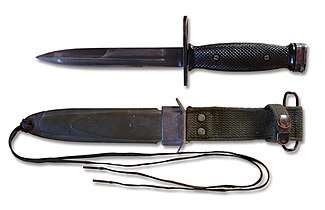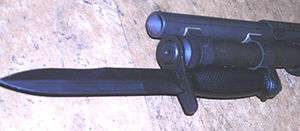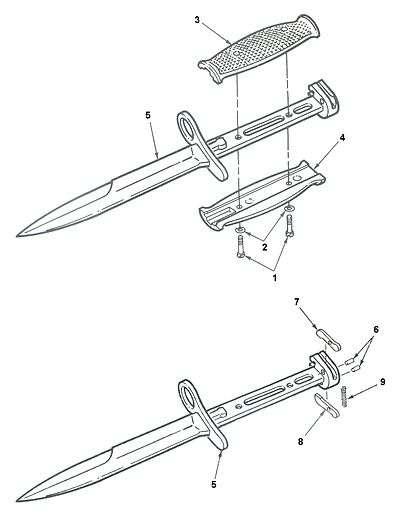M7 bayonet
The M7 bayonet is a bayonet that was used by the U.S. military for the M16 rifle, it can also be used with the M4 carbine as well as many other assault rifles, carbines and combat shotguns. It can be used as a fighting knife and utility tool. It was introduced in 1964, when the M16 rifle entered service during the Vietnam War.[1]
| M7 Bayonet | |
|---|---|
 M7 Bayonet & M8A1 Sheath | |
| Type | Bayonet |
| Place of origin | United States |
| Service history | |
| In service | 1964 – present |
| Used by | US Military |
| Wars |
|
| Production history | |
| Designed | 1944 for M4 bayonet |
| Manufacturer |
|
| Produced | 1964 - present |
| No. built | ~3 million |
| Specifications | |
| Length | 11.75 in (29.8 cm) |
| Blade length | 6.75 in (17.1 cm) |
| Blade type | Spear Point |
| Scabbard/sheath | M8, M8A1 & M10 |
Description


The M7 bayonet is very similar to the older M4 bayonet with the Korean War era plastic grips for the M1/M2 carbines except that the M7 has a much larger muzzle ring. The M7 has the same two-lever locking mechanism as the M4, that connects to a lug on the M16 rifle's barrel. The M4 (M1/M2 carbine), M5 (M1 rifle), and M6 bayonet (M14 rifle), all derived from the World War II M3 fighting knife.
The M7 differs from M6 bayonet for the M14 rifle.[2] Most notably, the diameter of the muzzle rings, and the locking mechanism. The M7's release mechanism is on the pommel, while the M6 has a spring-loaded lever near the guard that when depressed releases the bayonet. Both models are approximately the same length, have the same black finish, and use the M8A1, or later M10 sheath.
The M7's 1095 carbon steel blade is 6 3/4 inches long, with an overall length of 11.9 inches. Blade width is 3/16 inch and it weighs about 9.6 ounces. One edge is sharpened its full length while the opposite side of the blade has approximately 3 inches sharpened. There are no markings on the blade itself. The manufacturer's initials or name, along with "US M7", will be found stamped under the crossguard (see photo, right). The non-slip grips are molded black plastic. The steel parts have a uniform dark grey/black parkerized finish.
The M7 bayonet NSN is NSN 1095-00-017-9701. The initial contractor was Bauer Ord Company. Colt (manufacturer of the M16) and Ontario Knife Company made many of the M7 bayonets for the military and continue to make and sell them commercially. Other manufacturers included Carl Eickhorn [for Colt], Columbus Milpar & Mfg. (MIL-PAR), Conetta Mfg., Frazier Mfg., General Cutlery (GEN CUT), and Imperial Knife. The M7 was also manufactured in Canada, West Germany, the Philippines, Singapore, Israel, South Korea and Australia.
The M7 has been partially replaced by the M9 bayonet in Army service, and the Marine Corps replaced it with the OKC-3S bayonet. The Army, Navy, and USAF still use M7s and may do so for years to come.
M8 and M8A1 Scabbard
There are two variations of this scabbard, both with an olive drab fiberglass body with steel throat. The early version M8 scabbard only a had a belt loop and lacked the double hook that earlier bayonet scabbards had for attaching to load carrying equipment such as the M1910 Haversack. The improved M8A1 scabbard manufactured later in WW II has the M1910 bent wire hook. The scabbard throat flange is stamped "US M8" or "US M8A1" on the flat steel part along with manufacturer initials. Some M8 scabbards were later modified by adding the M1910 hook. Later M8A1 scabbards were manufactured with a modified extended tab on the web hanger to provide more clearance for the M5 bayonet which rubbed against the wider bayonet handle.[3] This sheath is correct for all post-war US bayonets including the M4, M5, M6, and M7. It was also used with the M3 fighting knife.
Exploded view

| Bayonet-Knife M7 | Item number |
|---|---|
| Screw, Machine, Grip | 1 |
| Washer, Lock | 2 |
| Grip, Bayonet-Knife, LH | 3 |
| Grip, Bayonet-Knife, RH | 4 |
| Blade Assembly M7 | 5 |
| Pin, Spring | 6 |
| Lever, Lock-Release, LH | 7 |
| Lever, Lock-Release, RH | 8 |
| Spring, Helical, Compression | 9 |
See also
- M3 fighting knife
- M4 bayonet used by the M1 carbine
- M5 bayonet used by the M1 Garand
- M6 bayonet used by the M14 rifle
- M9 bayonet used by the M16 rifle and M4 carbine
- List of individual weapons of the U.S. Armed Forces
References
- Russell Phillips (21 June 2011). This We'll Defend: The Weapons and Equipment of the U.S. Army. Shilka Publishing. pp. 10–. ISBN 978-1-4581-0420-5.
- Gordon Rottman (2011). The M16. Osprey Publishing. pp. 49–. ISBN 978-1-84908-690-5.
- http://www.usmilitaryknives.com/bayo_points_18.htm